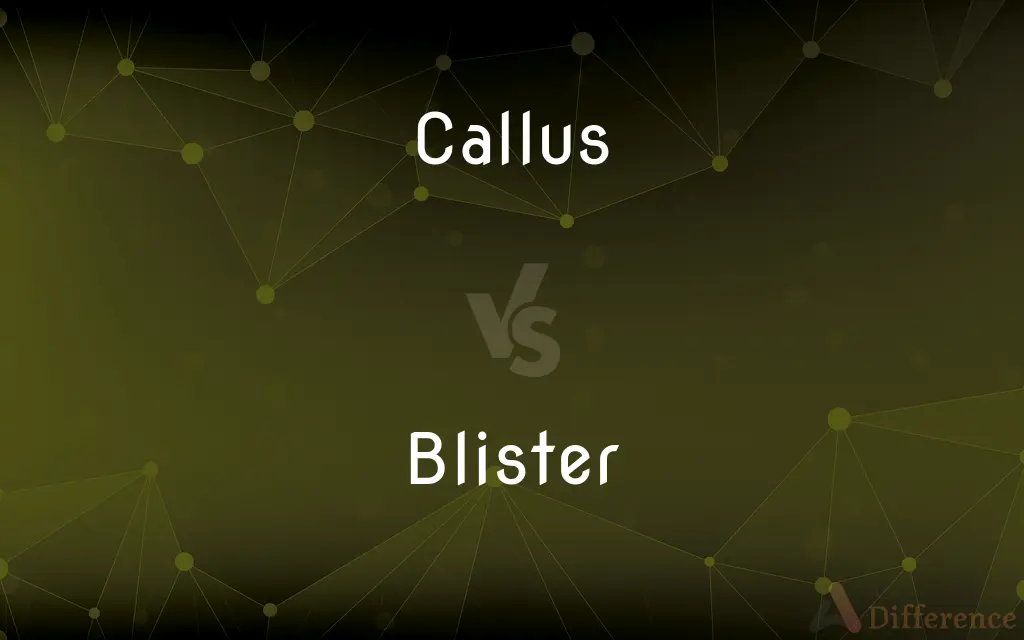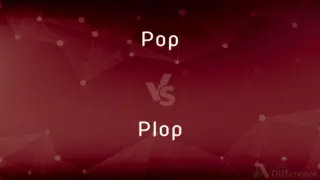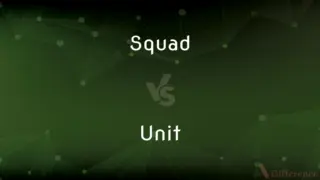Callus vs. Blister — What's the Difference?
By Tayyaba Rehman & Fiza Rafique — Updated on April 5, 2024
A callus forms due to repeated friction or pressure, creating thickened skin; a blister is a fluid-filled bubble on the skin caused by irritation or burn.

Difference Between Callus and Blister
Table of Contents
ADVERTISEMENT
Key Differences
A callus is the result of your skin's attempt to protect itself through thickening in response to repeated pressure or friction. This process happens over time and results in a hard, thickened patch of dead skin. Whereas, a blister forms quickly as a defense mechanism against acute damage, such as friction, burns, or freezing, trapping fluid beneath the skin's surface to cushion and protect the underlying tissue.
Calluses are often found on hands and feet, areas subjected to continuous friction or pressure from activities like manual labor or wearing ill-fitting shoes. This skin thickening is generally painless and develops gradually. On the other hand, blisters can appear on any part of the body that experiences irritation, including hands, feet, and even the torso, depending on the cause. They are usually painful or tender when touched.
While calluses provide a protective layer, reducing the risk of skin breaks and infection in high-friction areas, they can become uncomfortable if too thick or if they crack. Blisters, however, primarily act as a short-term protection mechanism, with the fluid serving to prevent further damage to the underlying skin and facilitate healing.
The development of a callus is a sign of the body adapting to repetitive stress, making the skin more resilient to similar challenges in the future. Conversely, a blister is an immediate response to prevent further injury, signaling the need to address the source of irritation or damage.
Management of calluses typically involves reducing the friction or pressure causing them, possibly with the help of protective pads or better-fitting shoes. In contrast, blisters often require protection against bursting, which can lead to infection. The recommended care includes gentle cleaning, covering with a sterile bandage, and avoiding further irritation.
ADVERTISEMENT
Comparison Chart
Definition
Thickened skin due to repeated pressure or friction.
Fluid-filled bubble caused by irritation.
Cause
Long-term friction or pressure.
Acute friction, burns, or freezing.
Location
Commonly on hands and feet.
Can occur anywhere on the body.
Development
Gradual, over time.
Quickly, in response to irritation.
Symptom
Hard, thickened skin; usually painless.
Tender, painful bubble.
Purpose
Protects against further pressure or friction.
Cushions and protects underlying tissue.
Management
Reduce friction/pressure; use protective pads.
Clean gently; cover; avoid further irritation.
Compare with Definitions
Callus
A hardened area of skin formed due to repeated friction.
She developed a callus on her finger from writing with a pencil.
Blister
A protective mechanism against skin damage.
The blister formed to protect the burn on his hand.
Callus
Thickened part of the skin on the foot caused by pressure.
Running shoes often cause a callus on the toes.
Blister
Requires careful management to prevent infection.
He covered the blister with a bandage to keep it clean.
Callus
A non-painful area of thick skin.
The callus on his palm was from years of manual labor.
Blister
Can appear after burns, freezing, or friction.
Freezing temperatures caused a blister to form on her cheek.
Callus
A sign of the skin adapting to stress.
Her hands had calluses from gardening without gloves.
Blister
A small bubble on the skin filled with serum, due to irritation.
She got a blister on her heel from new shoes.
Callus
A protective response of the skin to prolonged rubbing.
Guitarists frequently have calluses on their fingertips.
Blister
Often painful and tender to touch.
The blister on her foot made walking uncomfortable.
Callus
A callus is an area of thickened skin that forms as a response to repeated friction, pressure, or other irritation. Since repeated contact is required, calluses are most often found on the feet and hands, but they may occur anywhere on the skin.
Blister
A blister is a small pocket of body fluid (lymph, serum, plasma, blood, or pus) within the upper layers of the skin, usually caused by forceful rubbing (friction), burning, freezing, chemical exposure or infection. Most blisters are filled with a clear fluid, either serum or plasma.
Callus
A thickened and hardened part of the skin or soft tissue, especially in an area that has been subjected to friction.
Blister
A local swelling of the skin that contains watery fluid and is caused by burning or irritation.
Callus
A localized thickening and enlargement of the horny layer of the skin. Also called callosity.
Blister
A similar swelling on a plant.
Callus
The hard bony tissue that develops around the ends of a fractured bone during healing.
Blister
A raised bubble, as on a painted or laminated surface.
Callus
Undifferentiated tissue that develops on or around an injured or cut plant surface or in tissue culture.
Blister
A rounded, bulging, usually transparent structure, such as one used for observation on certain aircraft or for display and protection of packaged products.
Callus
The hardened, sometimes sharp base of the spikelet of certain grasses.
Blister
To cause a blister to form on.
Callus
To form or develop such hardened tissue. See Usage Note at callous.
Blister
To reprove harshly.
Callus
A hardened area of the skin (especially on the foot or hand) caused by repeated friction, wear or use.
Blister
To break out in or as if in blisters.
Callus
The material of repair in fractures of bone; a substance exuded at the site of fracture, which is at first soft or cartilaginous in consistency, but is ultimately converted into true bone and unites the fragments into a single piece.
Blister
A small bubble between the layers of the skin that contains watery or bloody fluid and is caused by friction and pressure, burning, freezing, chemical irritation, disease or infection.
Callus
(botany) The new formation over the end of a cutting, before it puts out rootlets.
Blister
A swelling on a plant.
Callus
(entomology) A shining area on the frons of many species of Tabanomorpha (horse flies and relatives).
Blister
(medicine) Something applied to the skin to raise a blister; a vesicatory or other applied medicine.
Callus
(intransitive) To form such hardened tissue.
Blister
A bubble, as on a painted surface.
Callus
Same as Callosity
Blister
(roofing) An enclosed pocket of air, which may be mixed with water or solvent vapor, trapped between impermeable layers of felt or between the membrane and substrate.
Callus
The new formation over the end of a cutting, before it puts out rootlets.
Blister
A type of pre-formed packaging made from plastic that contains cavities.
Blister card
Blister pack
Callus
An area of skin that is thick or hard from continual pressure or friction (as the sole of the foot)
Blister
A cause of annoyance.
Callus
Bony tissue formed during the healing of a fractured bone
Blister
(uncountable) A form of smelted copper with a blistered surface.
Callus
(botany) an isolated thickening of tissue, especially a stiff protuberance on the lip of an orchid
Blister
(transitive) To raise blisters on.
A chemical agent that blisters the skin
Callus
Cause a callus to form on;
The long march had callused his feet
Blister
To sear after blaching.
Callus
Form a callus or calluses;
His foot callused
Blister
(intransitive) To have a blister form.
Blister
(transitive) To criticise severely.
Blister
(intransitive) To break out in blisters.
Blister
A vesicle of the skin, containing watery matter or serum, whether occasioned by a burn or other injury, or by a vesicatory; a collection of serous fluid causing a bladderlike elevation of the cuticle.
And painful blisters swelled my tender hands.
Blister
Any elevation made by the separation of the film or skin, as on plants; or by the swelling of the substance at the surface, as on steel.
Blister
A vesicatory; a plaster of Spanish flies, or other matter, applied to raise a blister.
Blister
To be affected with a blister or blisters; to have a blister form on.
Let my tongue blister.
Blister
To raise a blister or blisters upon.
My hands were blistered.
Blister
To give pain to, or to injure, as if by a blister.
This tyrant, whose sole name blisters our tongue.
Blister
(pathology) an elevation of the skin filled with serous fluid
Blister
Get blistered;
Her feet blistered during the long hike
Blister
Subject to harsh criticism;
The Senator blistered the administration in his speech on Friday
The professor scaled the students
Your invectives scorched the community
Blister
Cause blisters to from on;
The tight shoes and perspiration blistered her feet
Common Curiosities
How can I prevent calluses?
Prevent calluses by wearing well-fitting shoes, using gloves during manual work, and applying protective pads to high-friction areas.
Are blisters dangerous?
Blisters themselves are not dangerous but can lead to infection if improperly managed or if they burst.
Can a callus turn into a blister?
No, a callus and a blister are distinct responses to different types of skin stress; one does not turn into the other.
Can calluses be removed?
Yes, calluses can be reduced or removed through exfoliation, moisturizing, and avoiding the repetitive pressure that caused them.
Why do blisters form fluid?
The fluid in blisters acts as a cushion to protect the underlying skin from further damage and promote healing.
How long do calluses and blisters take to heal?
Calluses do not need to heal as they are protective; they can be reduced over time with less friction. Blisters may heal within a few days to a week if not infected.
Are calluses a sign of a health problem?
Calluses are usually a sign of repeated pressure or friction, not necessarily a health problem, but can indicate ill-fitting shoes or an underlying condition that alters walking.
Should I pop a blister?
It's generally recommended not to pop a blister, as this can increase the risk of infection. Cover it with a sterile bandage instead.
How can I treat a blister at home?
Treat blisters at home by cleaning the area gently, applying an antibacterial ointment if needed, and covering it with a sterile bandage.
Can both calluses and blisters form on the feet?
Yes, both calluses and blisters can form on the feet, often due to wearing ill-fitting shoes or excessive walking or running.
Is it okay to continue activities that cause calluses?
Continuing activities that cause calluses is generally okay if measures are taken to protect the skin and the calluses are not causing discomfort.
What causes hand calluses?
Hand calluses are typically caused by repeated manual activities, such as using tools, playing instruments, or sports that involve gripping.
What is the fluid inside blisters?
The fluid inside blisters is usually serum, a clear part of the blood, or plasma without the blood cells, sometimes mixed with blood or pus if infected.
Can blisters appear without physical injury?
Yes, blisters can also form due to allergic reactions, infections, or autoimmune diseases, not just physical injury.
How can I prevent blisters when hiking?
Prevent blisters when hiking by wearing well-fitting boots, using moisture-wicking socks, and applying blister-preventive tape or bandages on known hot spots.
Share Your Discovery

Previous Comparison
Pop vs. Plop
Next Comparison
Squad vs. UnitAuthor Spotlight
Written by
Tayyaba RehmanTayyaba Rehman is a distinguished writer, currently serving as a primary contributor to askdifference.com. As a researcher in semantics and etymology, Tayyaba's passion for the complexity of languages and their distinctions has found a perfect home on the platform. Tayyaba delves into the intricacies of language, distinguishing between commonly confused words and phrases, thereby providing clarity for readers worldwide.
Co-written by
Fiza RafiqueFiza Rafique is a skilled content writer at AskDifference.com, where she meticulously refines and enhances written pieces. Drawing from her vast editorial expertise, Fiza ensures clarity, accuracy, and precision in every article. Passionate about language, she continually seeks to elevate the quality of content for readers worldwide.
















































